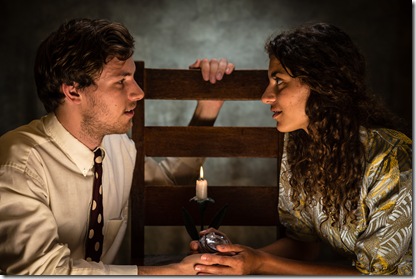The Glass Menagerie: A great tribute to an important play.
Photo. Courtesy of Bear & Co. Cory Thibert and Sarah Waisvisz
he 1930s were an era that quaked in the wake of the Great Depression. Americans had barely emerged from the horror that was the First World War before plummeting into financial ruin. Tennessee Williams, in his contemporary masterpiece The Glass Menagerie, captures in minute detail the heart of one working-class family who symbolize the convergence of history, family, and place—a trifecta that barres them from exacting any agency of their own.
Director Eleanor Crowder offers the audience a production that captures the listless, hopeless, and desperate spirit of Williams’ play, and emphasizes Tom Wingfield as the driving agent of this drama.
Even more than the characters themselves, the set design (by David Magladry) captures the austerity of the era. The Wingfields’ apartment features tired furniture, and Laura’s glass menagerie tucked away to stage left. However, Magladry literally wraps their apartment in another symbolic layer: Their modest apartment is framed by exposed set pieces. The fire escape, for example, is depicted through the use of a tall ladder, presumably used to access the lighting rig. A small drawing room to stage right uses metal framing to depict the back wall. All these elements reveal themselves to be part of Tom’s world outside of the play; they are tools that ask the audience to remember that this is a story created by Tom’s mind.
Naturalism requires a bit of a mind-bend: While the details of the stage-world are crafted to the utmost specificity and produce a “realistic” world even though the play relies much on symbolic elements. Crowder, alongside Magladry’s effective set, uses all opportunities to war against realism, and most notably in the direction of Amanda Wingfield (played by Rachel Eugster) and Laura Wingfield (played by Sarah Waizvisz). The mother and daughter are played with deliberate over-exaggeration, to the point that it comes across as robotic. In this production, they are, above all, characters in Tom’s memory play.
An inspired choice on Crowder’s part, but it ultimately diffuses the sentimental aspect of Tom’s play. Amanda and Laura both lose the subtle attributes of their characters—be it Amanda’s self-loathing under her Southern Belle charm, or Laura’s timidity underneath moments of childlike enthusiasm. Due to the style of acting imposed on Amanda and Laura, the play loses the “human desperation” that lies at the heart of each character in Williams’ text. What’s more, though Eugster plays Amanda as a delightfully loathsome mother hen, she loses control over the text by rushing through her lines. Amanda’s penchant to hold court for all who will listen fizzles as Eugster races through potent monologues.
But a star of the show emerges: Tom Wingfield, played by Tim Oberholzer is electric on stage. Oberholzer embodies both the nostalgic quality of “Tom outside the play” and the moody desperation of “Tom inside the play”. Crowder and Oberholzer reveal a wonderful partnership through the role of Tom Wingfield. Crowder’s staging asks that Tom remain both inside and outside of the stage world—for example, Tom might re-arrange a spotlight on stage, or cue music to begin. Oberholzer manages to embody moments of reflection before transforming into a caged animal under his mother’s thumb.
It is important to note that the play had a number of perceptible omissions. Laura’s limp is a cornerstone to her character, and yet, in this production she is portrayed through Tom, the “author’s” eyes: Without the limp that launches her into a reclusive adulthood. However, the point is that both Tom and Laura in fact do see the limp though they don’t want to admit it. They protect her and keep her safe because of her limp, like a glass figurine on a shelf.
Despite some inconsistencies between Williams’ text and Crowder’s interpretation, this is nonetheless a great tribute to an important piece. Watching the play is like sifting through sand, looking for treasures. You’ll certainly find a few.
